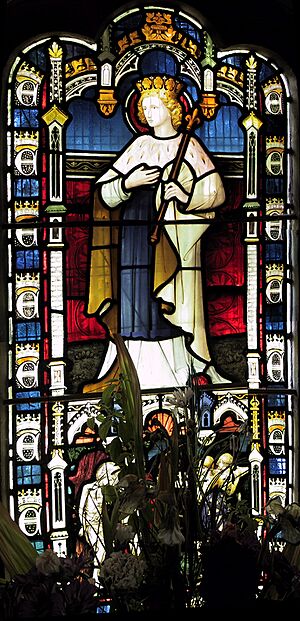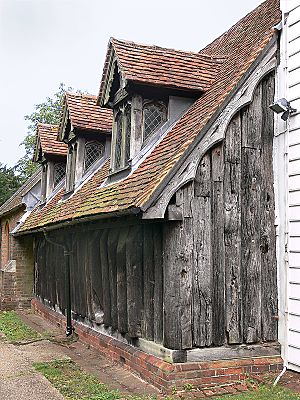Greensted Church facts for kids
Greensted Church is a very old church located in the small village of Greensted, near Chipping Ongar in Essex, England. Many people believe it is the oldest wooden church in the world. It might even be the oldest wooden building in Europe that is still standing today! While some parts have been changed over time, much of its original wooden structure remains. The church's walls are made from large oak tree trunks. Experts think it was built either in the mid-9th century or the mid-11th century.
This special building is officially known as The Church of St Andrew, Greensted-juxta-Ongar. It is a listed building with a Grade I status, meaning it's very important historically. Greensted Church is still used for services every week, just as it has been for hundreds of years.
Contents
A Long History: Greensted Church's Past
Greensted Church has likely been standing for almost 1,200 years. Scientists used a method called dendrochronology (tree-ring dating) to estimate when it was built. An early study suggested it was built around 845 AD. Later research, however, updated this date to 1053 AD, plus or minus a few years.
Before this wooden church was built, there might have been an even older church or a holy place on the same spot. Archaeological findings show traces of two simple wooden buildings under the current chancel floor. These older structures are thought to have been built in the late 6th or early 7th century. This was shortly after a missionary named Cedd began teaching Christianity to the people of the East Saxon kingdom around 654 AD.
The church is dedicated to St Andrew. This might suggest that its original foundation had Celtic roots. A famous story says that the body of King Edmund the Martyr of East Anglia rested here in 1013. King Edmund was killed in 870 AD. His body was being moved to be reburied at Bury St Edmunds. You can find many tributes to St Edmund inside the church today.
In 1839, a man named James Brine got married at Greensted Church. He was one of the Tolpuddle Martyrs, a group of farm workers who were sent away from England for protesting. After they returned, some were given land near Chipping Ongar. James Brine married Elizabeth Standfield here on June 20, 1839. The church's old records still show their marriage.
Greensted Church was even featured on a British postage stamp in 1972. This stamp was part of a series showing different village churches. In 1987, a new oak font was added to the church. It was designed by Hugh Casson and made by Russell Thomas.
How Greensted Church Was Built
Like many old buildings, Greensted Church has been changed and repaired many times over the centuries. Each period added something new to its unique look.
Early Building: Anglo-Saxon and Norman Times
The main part of the church, called the nave, is built from large, split oak tree trunks. This was a common way of building during the Anglo-Saxon period. Most of the nave is original. Tree-ring dating in the 1960s suggested it was built in 845 AD. However, later research in 1995 updated this date to 1053 AD, plus 10 to 55 years. This means the wood was likely cut between 1063 and 1108.
An interesting feature on the north side of the nave is a small opening. It was once called a "leper's squint." People thought it was a place where lepers, who couldn't enter the church, could still receive a blessing. However, because it's right next to the original doorway, experts now think it was probably a window. It would have been used to see who was approaching the church.
In the chancel (the area around the altar), you can still see the flint stone foundations of the wall. There is also a stone basin called a piscina inside the sanctuary. These are the only parts left from the Norman period of building. Near the church porch, a large, carved stone marks the burial place of an unknown knight.
Changes in the 16th Century
The original chancel was small and made of wood. But the current chancel, which is built from brick, was added during the 16th century. This was a significant change to the church's structure.
Additions from the 17th to 19th Centuries
The white weatherboarded tower was added during the Stuart period in the 17th century. This tower is often the first thing people notice about the church. One of the bells inside the tower has the inscription "William Land made me 1618." There are several other old wooden towers like this in the area.
Around this time, three dormer windows were added to the nave for the first time. The south porch was also built. You can see a small piece of 15th-century stained glass in the round window at the west end. However, this piece was placed there during the Victorian restoration. The oldest memorial on a wall inside the church is for Jone Wood, from 1585.
Victorian Restoration Work
During the Victorian era in the 19th century, a lot of reconstruction work was done. This added some detailed brickwork to the building. It also likely included some of the more decorative elements you see on the outside today. The Victorians replaced the three dormer windows with six new ones. The porch was also rebuilt, and other small changes were made, including new stone coping.




